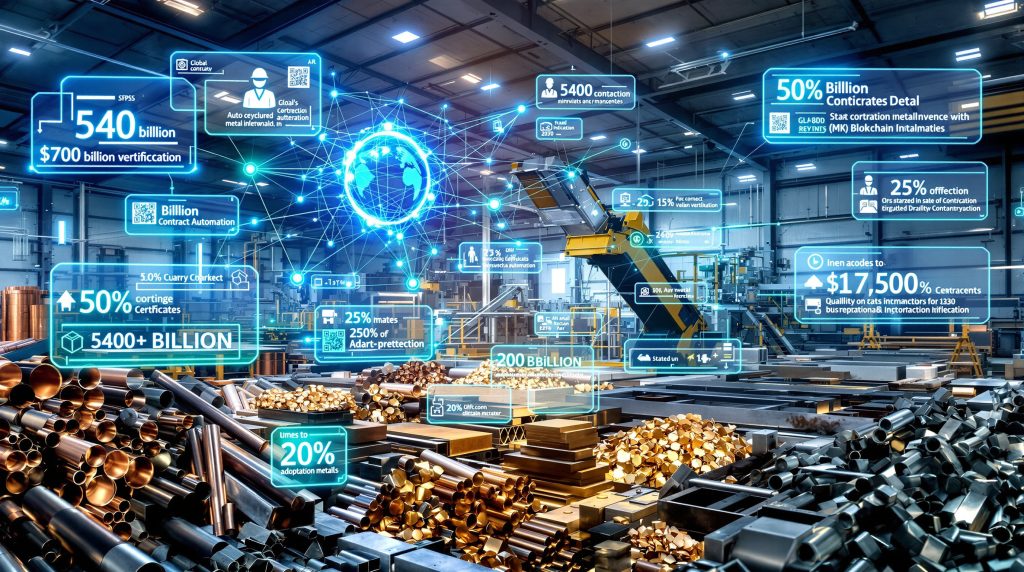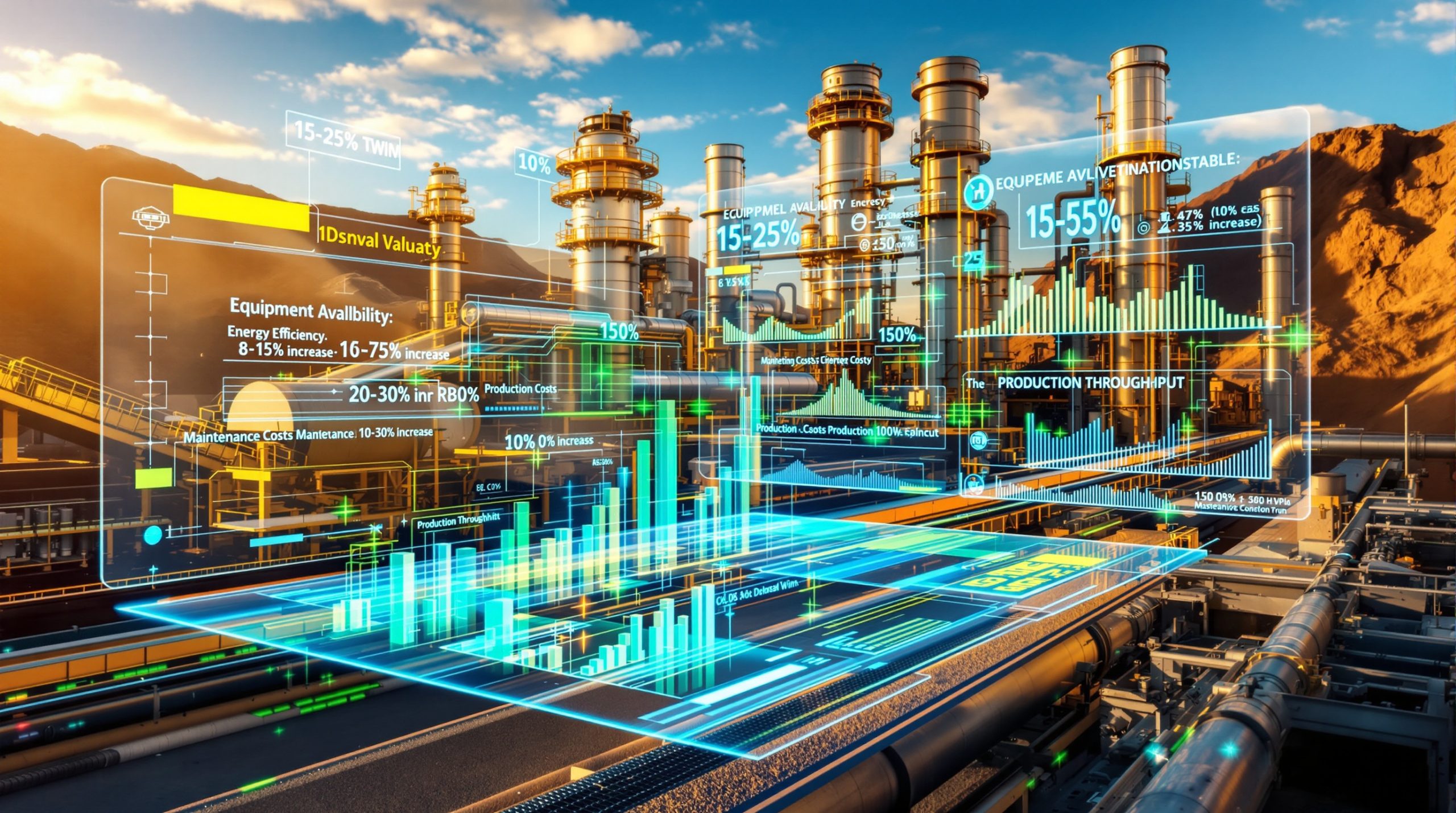The metal recycling industry stands at the threshold of a technological revolution. Blockchain in metal recycling represents far more than a simple digital upgrade; it fundamentally transforms how scrap materials move through complex supply chains. This distributed ledger technology creates an immutable record system that tracks every transaction, transformation, and transfer from initial collection through final processing. Furthermore, the integration of blockchain supports the broader mining industry evolution by establishing new standards for transparency and accountability.
Understanding Blockchain Technology in Metal Recycling
Modern blockchain systems in metal recycling consist of interconnected nodes that validate and record transactions across multiple participants. Each participant maintains a synchronized copy of the ledger, eliminating single points of failure. The system typically includes:
- Digital wallets for secure transaction management
- Smart contract protocols for automated execution
- Consensus mechanisms ensuring data integrity
- Cryptographic security layers protecting sensitive information
Digital Verification Transforms Material Tracking
Traditional paper-based tracking systems create vulnerabilities where documents can be lost, altered, or falsified. Blockchain technology addresses these limitations by creating digital certificates that accompany metal batches throughout their lifecycle. These certificates contain embedded metadata about composition, origin, and processing history that cannot be modified without detection.
The transformation from analog to digital verification enables real-time monitoring and instant validation of material authenticity, dramatically reducing processing delays and administrative overhead.
Why Metal Recyclers Embrace Blockchain Solutions
The global metal recycling market represents a substantial economic sector with unique operational challenges. Industry participants face persistent issues with material authenticity, supply chain transparency, and regulatory compliance that blockchain technology directly addresses. Moreover, this technological advancement aligns with the industry's sustainability transformation initiatives.
Addressing Transparency Gaps in Traditional Recycling Chains
Conventional recycling operations often involve multiple intermediaries, creating information silos that obscure material origins. Blockchain in metal recycling eliminates these blind spots by providing complete visibility into material movement. According to research on blockchain transparency in metal recycling, recyclers can now trace materials back to their original sources, enabling better quality control and contamination prevention.
The technology ensures that recycled metals maintain verifiable documentation throughout processing, addressing longstanding concerns about material legitimacy and quality assurance.
Combating Fraud and Contamination Issues
Fraudulent materials and contamination represent significant economic losses for recyclers. Blockchain systems create tamper-resistant records that make it nearly impossible to introduce undocumented materials into legitimate supply chains. This capability becomes particularly valuable when dealing with high-value metals where contamination can destroy entire batches.
The immutable nature of blockchain records provides recyclers with confidence in their material sources, reducing risk exposure and enabling premium pricing for verified clean materials.
Meeting Regulatory Compliance Requirements
Environmental regulations increasingly demand detailed documentation of material origins and processing methods. Blockchain technology automatically generates the comprehensive audit trails required for regulatory reporting, significantly reducing administrative burdens while ensuring compliance accuracy.
Key Industry Statistics:
| Metric | Current Status |
|---|---|
| Global metal recycling market | Estimated $400+ billion annually |
| Documentation errors in traditional systems | 15-20% of transactions affected |
| Regulatory compliance costs | 8-12% of operational expenses |
Note: Market size estimates vary by source and methodology. Specific fraud loss percentages require verification through specialised industry reports.
How Blockchain Creates Tamper-Proof Metal Tracking
The fundamental strength of blockchain in metal recycling lies in its ability to create permanent, unalterable records. Unlike traditional databases that can be modified by administrators, blockchain systems require consensus from multiple network participants before any changes can be recorded. This approach complements data-driven operations by providing reliable data foundations.
Digital Identity Creation for Scrap Metal Batches
Each batch of recycled metal receives a unique digital identity containing essential characteristics such as alloy composition, weight, processing date, and origin facility. This digital fingerprint follows the material through every stage of processing, creating an unbreakable chain of custody.
The digital identity system enables automated quality control by comparing current specifications against historical baselines, immediately flagging any discrepancies that might indicate contamination or processing errors.
Immutable Transaction Recording Systems
Every transaction involving recycled metals generates a permanent record that includes:
- Timestamp data with precise date and time information
- Participant identities for all parties involved in the transaction
- Material specifications including weight, composition, and quality metrics
- Location data tracking geographic movement
- Processing details documenting any treatments or modifications
These records become part of the permanent blockchain ledger, accessible to authorised participants while remaining protected from unauthorised modifications.
Real-Time Chain of Custody Documentation
Traditional chain of custody documentation often lags behind actual material movement, creating gaps where materials can be substituted or contaminated without detection. Blockchain systems enable instantaneous updates as materials change hands, providing real-time visibility into location, condition, and ownership.
This capability proves particularly valuable for high-value materials like copper, aluminium, and speciality alloys where precise tracking directly impacts profitability.
Smart Contracts Revolutionising Metal Recycling Operations
Smart contracts represent one of blockchain's most transformative applications in metal recycling. These self-executing programs automatically enforce contractual terms without human intervention, streamlining operations and reducing disputes. This technology advancement supports the development of modern waste management solutions across the industry.
Automated Payment Processing Upon Quality Verification
Traditional payment systems in metal recycling often involve lengthy verification processes that delay compensation for suppliers. Smart contracts eliminate these delays by automatically triggering payments when predefined quality standards are met.
The system integrates with testing equipment to verify material specifications, instantly releasing payment when compositions fall within acceptable ranges. This automation reduces payment cycles from weeks to minutes while eliminating disputes over material quality.
Conditional Contract Execution Based on Weight and Purity
Smart contracts can incorporate complex conditional logic that accounts for variations in material quality and market conditions. For example, contracts might specify different payment rates based on:
- Metal purity levels (95%, 98%, 99.9%)
- Batch sizes with volume discounts
- Contamination thresholds affecting pricing
- Market conditions with dynamic pricing adjustments
This sophistication enables more nuanced business relationships while maintaining complete transparency in pricing mechanisms.
Eliminating Intermediary Dependencies
Traditional recycling transactions often require banks, brokers, and inspection services to facilitate deals between parties. Smart contracts enable direct peer-to-peer transactions by embedding verification and payment mechanisms directly into the blockchain system.
Process Efficiency Comparison:
| Aspect | Traditional Process | Blockchain Smart Contracts |
|---|---|---|
| Payment processing | 7-14 business days | Immediate upon verification |
| Quality verification | Manual inspection required | Sensor-triggered validation |
| Dispute resolution | Third-party mediation | Automated rule enforcement |
| Transaction costs | 3-5% of transaction value | 0.5-1.5% of transaction value |
Note: Efficiency metrics represent industry estimates and may vary based on specific implementation details and market conditions.
Integrated Technologies Enhancing Blockchain Metal Recycling
Blockchain in metal recycling achieves maximum effectiveness when combined with complementary technologies that provide accurate data input and automated monitoring capabilities. This integration represents part of the broader AI integration in mining trend transforming resource industries.
IoT Sensors for Automated Data Collection
Internet of Things (IoT) sensors provide continuous monitoring of material conditions throughout the recycling process. These devices automatically feed data into blockchain systems, ensuring accurate and timely record updates without manual intervention.
Sensor types commonly deployed include:
- Weight sensors providing precise mass measurements
- Temperature monitors tracking processing conditions
- Chemical analysers determining composition in real-time
- Location beacons enabling geographic tracking
This sensor integration eliminates human error in data entry while providing comprehensive monitoring capabilities previously impossible with manual systems.
AI-Powered Material Classification Systems
Artificial intelligence algorithms enhance blockchain systems by automatically classifying materials and predicting quality characteristics. Machine learning models trained on historical data can identify material types, predict processing outcomes, and flag potential contamination issues before they impact operations.
AI classification proves particularly valuable when dealing with mixed metal streams where rapid identification enables optimal sorting and processing decisions.
LiDAR and Drone Integration for Inventory Management
Advanced inventory management systems combine drone technology with Light Detection and Ranging (LiDAR) sensors to create three-dimensional maps of scrapyard stockpiles. These systems provide accurate volume measurements and inventory tracking that integrate directly with blockchain record systems.
Drone-based inventory systems offer several operational advantages:
- Safety improvements by reducing personnel exposure to hazardous materials
- Accuracy enhancements through automated measurement systems
- Real-time monitoring enabling dynamic inventory optimisation
- Cost reductions by eliminating manual counting processes
The combination of drone technology, LiDAR mapping, and blockchain record-keeping creates comprehensive inventory management systems that provide unprecedented visibility into material flows and storage optimisation opportunities.
Material Authenticity Verification Through Blockchain
Verifying the authenticity of recycled metals represents a critical challenge that blockchain technology addresses through comprehensive documentation and verification systems. The development of these systems reflects broader innovations in metal recycling that are reshaping the industry.
Origin Certification and Source Verification
Blockchain systems maintain detailed records of material origins, including the specific facilities, processes, and timeframes involved in initial collection and processing. This documentation enables recyclers to verify that materials come from legitimate sources and meet sustainability standards.
Origin certification becomes particularly important for industries requiring conflict-free materials or specific environmental compliance standards. Blockchain records provide the comprehensive documentation needed to satisfy these requirements.
Composition Analysis Recording
Advanced spectroscopic analysis equipment integrates with blockchain systems to provide precise material composition data. Each analysis becomes part of the permanent record, enabling downstream processors to verify material specifications and optimise processing parameters.
Composition analysis records typically include:
- Primary metal percentages for base materials
- Alloy element concentrations for speciality metals
- Contamination levels for quality assessment
- Trace element analysis for specific applications
Quality Control Milestone Documentation
Throughout the recycling process, materials pass through various quality control checkpoints where specific tests verify compliance with standards. Blockchain systems automatically record these milestones, creating a comprehensive quality history that follows materials to end users.
Quality control documentation provides confidence to manufacturers using recycled materials, enabling premium pricing for materials with comprehensive verification records.
Implementation Challenges for Blockchain in Metal Recycling
Despite its significant potential, blockchain adoption in metal recycling faces several substantial obstacles that companies must navigate carefully.
Industry-Wide Standardisation Requirements
Blockchain systems achieve maximum effectiveness when all participants use compatible protocols and data formats. The metal recycling industry currently lacks standardised approaches for blockchain implementation, creating fragmentation that limits system interoperability.
Successful blockchain deployment requires coordination among recyclers, processors, manufacturers, and technology providers to establish common standards for data exchange and verification protocols.
Initial Infrastructure Investment Costs
Implementing comprehensive blockchain systems requires significant upfront investments in technology infrastructure, sensor equipment, and software development. Small and medium-sized recyclers often find these costs prohibitive, creating adoption barriers that could limit industry-wide benefits.
Investment Categories:
- Software licensing and development: $25,000-$75,000 annually
- Sensor and monitoring equipment: $50,000-$150,000 initial
- Integration and training costs: $15,000-$40,000 one-time
- Ongoing maintenance and support: $10,000-$25,000 annually
Note: Cost estimates vary significantly based on operation size, complexity, and specific technology choices.
Technical Literacy and Training Needs
Blockchain technology requires specialised knowledge that many recycling industry professionals currently lack. Successful implementation demands comprehensive training programmes that help staff understand system operations, troubleshooting procedures, and optimisation techniques.
The learning curve for blockchain systems can be steep, particularly for organisations with limited technology backgrounds. Companies must invest in ongoing education and potentially recruit additional technical personnel to support system operations.
Global Leadership in Blockchain Metal Recycling
Several organisations worldwide are pioneering blockchain applications in metal recycling, demonstrating the technology's practical potential while addressing implementation challenges.
Supply Chain Transparency Solutions
Leading technology providers focus on creating comprehensive transparency solutions that connect all participants in metal recycling supply chains. These systems enable complete material tracking from initial collection through final product manufacturing.
Transparency solutions typically provide stakeholders with access to:
- Real-time location tracking for material shipments
- Quality verification records throughout processing
- Environmental impact documentation for sustainability reporting
- Regulatory compliance evidence for audit purposes
Blockchain Integration Projects
Major recycling companies are implementing pilot programmes that test blockchain technology in controlled environments before full-scale deployment. These projects provide valuable learning experiences while demonstrating practical benefits to industry stakeholders.
Successful pilot programmes typically focus on specific material types or geographic regions, allowing companies to refine their approaches before expanding to full operations.
Digital Verification Systems
Specialised technology companies are developing comprehensive digital verification platforms that combine blockchain record-keeping with advanced material analysis capabilities. These systems provide end-to-end solutions for material tracking, quality verification, and payment processing.
Digital verification platforms often incorporate multiple technologies including blockchain, IoT sensors, artificial intelligence, and mobile applications to create user-friendly systems that address practical operational needs.
Supporting Sustainable Metal Recycling Goals
Blockchain technology aligns closely with sustainability objectives by enabling more efficient resource utilisation and reducing environmental impacts associated with metal production.
Preventing Illegal Material Circulation
Comprehensive tracking systems make it extremely difficult for illegally obtained or contaminated materials to enter legitimate recycling streams. Blockchain records provide clear documentation of material origins and processing history, enabling rapid identification of suspicious materials.
This capability proves particularly valuable in preventing theft of valuable metals and ensuring compliance with import/export regulations governing recycled materials.
Enhancing Circular Economy Metrics
Blockchain systems provide the detailed data needed to measure and optimise circular economy performance. Organisations can track material recovery rates, processing efficiency, and environmental impacts with unprecedented precision.
Circular Economy Benefits:
- Material recovery optimisation through detailed flow analysis
- Waste reduction via improved sorting and processing
- Energy efficiency through optimised transportation and processing
- Carbon footprint reduction by minimising virgin material demand
Supporting ESG Compliance Reporting
Environmental, Social, and Governance (ESG) reporting requirements increasingly demand detailed documentation of sustainability practices. Blockchain systems automatically generate the comprehensive records needed for ESG compliance while ensuring data accuracy and completeness.
ESG reporting capabilities enable companies to demonstrate their commitment to sustainable practices while meeting investor and regulatory requirements for transparency.
Return on Investment for Blockchain Implementation
Metal recyclers considering blockchain adoption must carefully evaluate potential returns against implementation costs to make informed investment decisions.
Cost Reduction Through Process Automation
Blockchain systems eliminate many manual processes that currently consume significant labour resources. Automated verification, payment processing, and record-keeping reduce administrative costs while improving accuracy and speed.
Process automation benefits include:
- Reduced documentation errors saving rework costs
- Faster transaction processing improving cash flow
- Eliminated duplicate data entry reducing administrative overhead
- Automated compliance reporting reducing regulatory costs
Revenue Enhancement via Premium Pricing
Materials with comprehensive blockchain verification often command premium prices from manufacturers seeking high-quality inputs with verified sustainability credentials. These premiums can offset implementation costs while providing ongoing revenue improvements.
Premium pricing opportunities arise from:
- Verified material purity enabling speciality applications
- Documented sustainability credentials meeting ESG requirements
- Guaranteed supply chain integrity reducing buyer risk
- Traceable origin documentation supporting regulatory compliance
Risk Mitigation and Insurance Benefits
Comprehensive blockchain documentation reduces operational risks related to material quality, regulatory compliance, and supply chain disruptions. Insurance providers may offer reduced premiums for operations with robust tracking and verification systems.
ROI Projections:
| Benefit Category | Estimated Annual Impact |
|---|---|
| Process automation savings | 15-25% of operational costs |
| Premium pricing opportunities | 8-12% revenue increase |
| Risk mitigation benefits | 3-5% of total revenue |
| Insurance premium reductions | 10-20% of coverage costs |
Note: ROI projections represent industry estimates and actual results may vary based on specific implementation approaches and market conditions.
Future Developments in Blockchain Metal Recycling
The intersection of blockchain technology and metal recycling continues evolving as new applications emerge and existing systems mature.
Integration with Carbon Credit Systems
Future blockchain systems will likely integrate with carbon credit markets, enabling recyclers to automatically generate and trade credits based on verified environmental benefits. This integration could create additional revenue streams while supporting global climate objectives.
Carbon credit integration requires sophisticated measurement and verification systems that blockchain technology can provide through its immutable record-keeping capabilities.
Cross-Industry Supply Chain Connectivity
Blockchain networks will expand beyond metal recycling to encompass entire manufacturing supply chains, enabling seamless material tracking from recycling through final product assembly. This connectivity will provide unprecedented visibility into global material flows.
Cross-industry integration demands standardised protocols and data formats that enable interoperability between different blockchain networks and industry systems.
Regulatory Framework Development
Government agencies worldwide are developing regulatory frameworks that govern blockchain applications in recycling and manufacturing. These frameworks will provide clarity for implementation while ensuring consumer protection and environmental compliance.
Regulatory development requires collaboration between industry stakeholders, technology providers, and government agencies to create balanced approaches that encourage innovation while maintaining appropriate oversight.
Implementation Roadmap for Metal Recyclers
Organisations considering blockchain adoption should follow structured implementation approaches that minimise risks while maximising benefits.
Pilot Programme Development Strategies
Successful blockchain implementation typically begins with limited pilot programmes that test specific applications before full-scale deployment. Effective pilot programmes focus on:
- Specific material types with high value or traceability requirements
- Limited geographic scope enabling close monitoring and support
- Defined success metrics measuring performance improvements
- Stakeholder engagement ensuring user acceptance and feedback
Pilot programmes provide valuable learning experiences while demonstrating practical benefits to internal stakeholders and external partners.
Technology Partner Selection Criteria
Choosing appropriate technology partners significantly impacts implementation success. Key selection criteria include:
- Industry experience with metal recycling applications
- Technical capabilities matching specific operational requirements
- Integration expertise connecting blockchain with existing systems
- Support infrastructure providing ongoing maintenance and updates
- Financial stability ensuring long-term partnership viability
Staff Training and Change Management
Blockchain implementation requires comprehensive training programmes that help staff understand new systems and processes. Effective training approaches include:
- Role-specific instruction tailored to individual responsibilities
- Hands-on practice with actual system interfaces and procedures
- Ongoing support addressing questions and challenges during adoption
- Change management strategies helping staff adapt to new workflows
Implementation Timeline:
-
Assessment Phase (Months 1-2):
- Current process evaluation and documentation
- Blockchain readiness assessment and gap analysis
- Technology partner selection and contract negotiation
-
Pilot Development (Months 3-6):
- Limited-scope system deployment and testing
- Staff training and process refinement
- Performance measurement and optimisation
-
Full Deployment (Months 7-12):
- Company-wide system implementation
- Comprehensive staff training and support
- Integration with existing business systems
-
Optimisation (Ongoing):
- Continuous performance monitoring and improvement
- Feature expansion and capability enhancement
- Industry collaboration and standardisation participation
Disclaimer: The projections, market analyses, and technology assessments presented in this article are based on current industry trends and available information. Actual implementation results may vary significantly based on specific operational conditions, market dynamics, and technology evolution. Companies considering blockchain implementation should conduct thorough due diligence and consult with qualified technology professionals before making investment decisions. ROI estimates and cost projections should be verified against current market conditions and specific operational requirements.
Ready to Capitalise on Emerging Technology Trends in Metal Markets?
Blockchain technology's transformation of metal recycling represents just one facet of the broader technological evolution reshaping resource industries. Discovery Alert's proprietary Discovery IQ model monitors significant ASX mineral discoveries across all sectors, including companies developing innovative technologies that could revolutionise traditional mining and recycling operations. Begin your 30-day free trial today to position yourself ahead of emerging investment opportunities in technology-driven resource companies.




